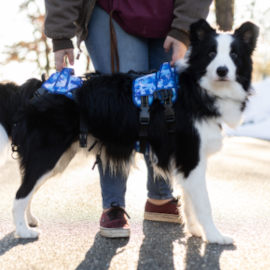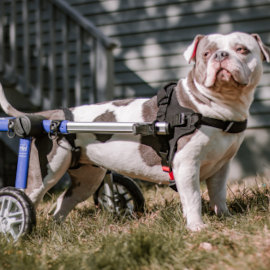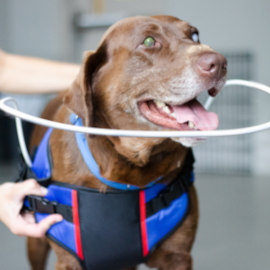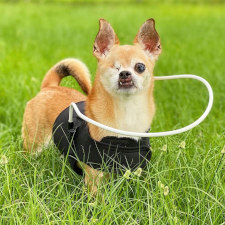November is Adopt a Senior Pet Month! Here are some changes that may happen and what you can expect.
How to help a senior dog improve its mobility
Senior Dog Joint Supplements
Joint support is important for every dog, but especially as a dog moves into their golden years. A high-strength joint supplement can help mobility, support joint structure, and aid occasional stiff joints with ingredients like Green Lipped Mussel and added fish oil to provide a concentrated source of Omega-3 to help lubricate your senior dog’s joints.
A harness to give them a boost

Lifting an older dog up off the ground can strain your back. Look for a harness or rear support leash that will easily slip up your dog’s back legs so that you can easily help them to stand up.
A lift harness is also a great way to assist an older dog up the stairs or safely lift your dog into a car.
Dog boots to help with traction
Many older dogs have a harder time getting their grip on slippery surfaces. Tile and hardwood floors can be tricky for a senior dog to walk on. Wearing dog boots inside your home can make it easier for your pup to walk safely without having to worry about slipping or falling.
Dog wheelchair

Struggles with balance and weakening back legs are common issues in an older dog. A dog wheelchair gives older pets the hind leg support they need to stand confidently and maintain their balance.
A dog wheelchair is a great way to help a senior dog to stay active and keep on enjoying their daily walk.
Deafness in senior dogs
In a young dog, their hearing is one of their keenest senses. But hearing loss and even deafness can develop as a dog gets older. Dogs usually experience age-related hearing loss due to the degenerative changes that occur in the nerves and hair cells of their ears. Hearing loss isn’t something that happens overnight, this usually occurs slowly over time until your dog becomes less responsive and no longer reacts to the noises around them.
Although this can be frustrating and even scary when your dog doesn’t come when called, becoming deaf has very little impact on your dog’s day-to-day life. A deaf dog will react to vibrations in the floor from footsteps, they can pick up visual cues (like a light turning on or a hand signal), so you can still communicate with your dog, you just need to find new ways of doing so.
How to communicate with a deaf dog
Use hand signals
When a dog loses its hearing, you need to change how you communicate with them. One of the simplest changes you make is to switch to hand signals since you can no longer rely on vocal cues. Many dog trainers will use both. Most likely, your dog already knows a few hand signals that they learned as a pup or that you use without thinking about it.
Vision Loss in senior dogs

There are many eye conditions that can impact a senior dog’s vision. Usually, the signs that a dog’s vision is impaired are very noticeable. Your dog’s eyes may look different (cloudy or filmy), they may begin to bump into walls or furniture, and your dog may be less confident on the stairs or struggle to get around in the dark. Depending on what’s causing your dog’s blindness, it can seemingly occur overnight.
Senior dogs with problems seeing need to be assessed by a veterinarian. Canine eye conditions run the gambit from mild and treatable to painful and may not be reversible. Only a veterinarian can help to properly diagnose and treat your dog’s vision problems. Although it will be a life adjustment for the entire family, a blind dog can adapt very well to a life without sight.
How to help a senior dog that can’t see:
Home Safety for a Blind Pet
Your home is your dog’s safe place and where they feel the most comfortable. You can do simple things to keep your blind pet safe in formerly familiar surroundings, such as clear the floor of any clutter or tripping hazards and block stairways with a pet gate. Your dog may be hesitant at first to move around without your help, and that’s ok. Take the time to help your dog map out the house, guide your dog around the house, and point out key locations by letting them sniff around and use verbal cues to guide them toward the food, water, and their favorite toys.
Avoid Moving Furniture
Any significant changes to the layout of your home will be jarring for a blind pet. While your dog is first adjusting to their vision loss, only make changes that are intended to keep your pet safe (such as keeping the floor clear). Major changes such as replacing furniture or changing the layout of a room should be avoided as much as possible. Significant changes will confuse your pet and be like a whole new space that they need to familiarize themselves with.
Blind Dog Halo

Moving around without being able to see can lead to bumped heads and cause a blind dog to become confused. A blind dog mobility aid, such as a Blind Dog Halo, is a wearable harness that acts as a bumper around the dog’s head.
A halo helps to keep a blind pet safe by alerting them of any nearby obstacles before they bump into them. By wearing a halo, a blind dog or cat will regain a bit of independence and rebuild their confidence as they learn to safely move around their home.
Dementia in senior dogs
Doggy dementia is more common in older dogs than you may think. Typically, an older dog will develop signs of dementia slowly over an extended period, and the signs can be subtle and even misattributed as a normal part of aging.
Common signs of dementia in senior dogs include:
- Behavior changes
- Forgetting commands
- Restless pacing and wandering
- Disorientation and confusion
- Sleeping more often during the day
- Not recognizing family members
- Increased vocalization, especially at night.
Dogs that have exhibited any changes in their behavior should be seen by a veterinarian as soon as possible.
Canine Cognitive Dysfunction (CCD)
Canine dementia is a condition that affects a dog’s brain, much like Alzheimer’s disease in humans. The symptoms of Canine Cognitive Dysfunction are similar to many different health issues, only a vet can correctly diagnose a dog with CCD.
The exact cause of doggy dementia is not yet known, but it is thought to be linked to physical and chemical changes that occur in the brain as dogs age. Behavioral changes can occur slowly with CCD, so it’s often undiagnosed.
How to help a dog with dementia
Just like Alzheimer’s, there is no cure for dementia in dogs although medication, medical care, and leading a healthy and enriched life can improve a dog’s quality of life. Always consult your veterinarian on the best way to improve a senior dog’s brain health, but here are a few simple changes that you can make to keep your dog’s mind and body active.
Enrichment
Keeping your dog’s mind sharp and engaged can help to prevent the onset of dementia. Contrary to popular belief, you can teach an old dog new tricks. And doing so can help to keep your older dog mentally stimulated!
Diet and Exercise
Regular exercise is a great way to promote a healthy lifestyle for your pup. Keeping your pet active by taking them for daily walks or playing games with them is an excellent way to ensure their overall well-being and stimulate their mind.
Dogs with Canine Cognitive Dysfunction often need a diet that is high in antioxidants and other brain-supporting nutrients. Your veterinarian may suggest your dog takes a daily supplement to support your dog’s brain health.
Changes in Daily Routine
Stick to a routine, your dog’s routine is comforting to them and can help reduce anxiety. But understand that a geriatric dog’s needs are very different from a younger pup and your regular plan may need to be adjusted as your dog’s condition changes.
Dogs with dementia are more prone to having accidents inside the house. Pet parents should expect to take their dogs out more often. As your dog’s cognitive abilities are impacted, they may not recognize the signs that they need to pee or poop or forget to ask to go outside. Modify your routine so that you can get your dog outside more often.
For dogs that struggle to sleep at night, you may need to add an extra walk before bed or a little playtime to tire them out a bit to encourage them to go to sleep.
Special shout out to Walkin’ Pets for the information about Senior Dogs so we can share this information with you!

